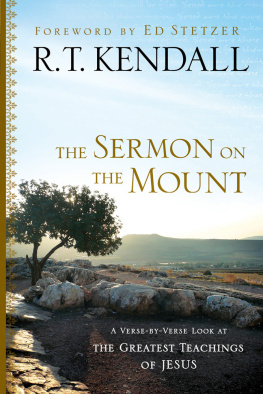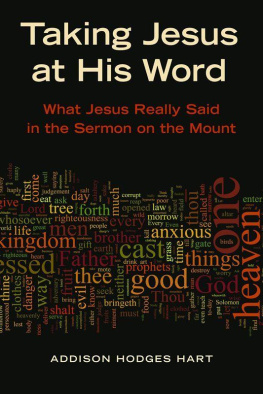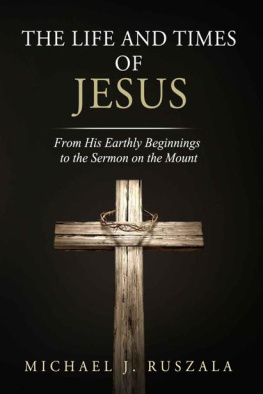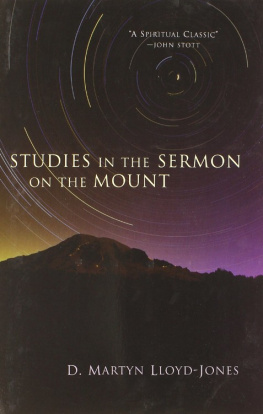Toward the
Kingdom of Heaven
Toward the Kingdom of Heaven:
40 Daily Readings on the Sermon on the Mount
Toward the Kingdom of Heaven
978-1-7910-0915-1
978-1-7910-0916-8 eBook
Sermon on the Mount:
A Beginners Guide to the Kingdom of Heaven
978-1-5018-9989-8
978-1-5018-9990-4 eBook
Sermon on the Mount: DVD
978-1-5018-9993-5
Sermon on the Mount: Leader Guide
978-1-5018-9991-1
978-1-5018-9992-8 eBook
Also by Amy-Jill Levine
Entering the Passion of Jesus: A Beginners Guide to Holy Week
Light of the World: A Beginners Guide to Advent
AMY-JILL LEVINE
TOWARD
the
KINGDOM
of
HEAVEN
40 DAILY READINGS
on the
SERMON on the MOUNT

Toward the Kingdom of Heaven
40 Daily Readings on the Sermon on the Mount
Copyright 2020 Amy-Jill Levine
All rights reserved.
No part of this work may be reproduced or transmitted in any form or by any means, electronic or mechanical, including photocopying and recording, or by any information storage or retrieval system, except as may be expressly permitted by the 1976 Copyright Act or in writing from the publisher. Requests for permission can be addressed to Permissions, The United Methodist Publishing House, 2222 Rosa L. Parks Blvd., Nashville, TN 37228-1306 or emailed to .
Library of Congress Control Number: 2020941646
978-1-7910-0915-1
Unless noted otherwise, Scripture quotations are from the New Revised Standard Version Bible, copyright 1989 National Council of the Churches of Christ in the United States of America. Used by permission. All rights reserved worldwide. http://nrsvbibles.org/
Scripture quotations noted CEB are taken from the Common English Bible, copyright 2011. Used by permission. All rights reserved.
Scripture quotations noted KJV are from The Authorized (King James) Version. Rights in the Authorized Version in the United Kingdom are vested in the Crown. Reproduced by permission of the Crowns patentee, Cambridge University Press.
20 21 22 23 24 25 26 27 28 29 10 9 8 7 6 5 4 3 2 1
MANUFACTURED IN THE UNITED STATES OF AMERICA
For
Mike Glenn
Rubel Shelly
Rob Simbeck
And with gratitude to
Randy Horick

CONTENTS

INTRODUCTION
From its opening verse, When Jesus saw the crowds, he went up the mountain; and after he sat down, his disciples came to him (Matthew 5:1) to the beginning of the sermon, Blessed are the poor in spirit, for theirs is the kingdom of heaven (Matthew 5:3), to Jesuss closing words about the houses on firm and weak foundations, to the crowds astonished reaction, the Sermon on the Mount beckons to us in multiple ways.
Its evocations of the Scriptures of Israel (what would be called the Old Testament) show us how Jesus both interprets and fulfills the Law (the Torah) and the Prophets, and so it cannot be understood fully unless we see that continuity with Abraham, Moses, and David.
Its comforting Beatitudes lead inexorably to its challenging ethics, all the while providing disciples the assurance that they really can be the light of the world and the salt of the earth. Its ability to get to the heart of the commandmentsdo not murder becomes do not be angry; do not commit adultery becomes do not lustbegins the discussion of how the body and the mind must work together. So, too, its teachings against hypocrisy help us to engage in needed introspection for getting the logs out of our own eyes.
Perhaps the best-known part of the Sermon on the Mount is the Our Father prayer. With attention to the meaning of the Greek, and suggestions concerning the underlying Hebrew or Aramaic, we can hear these ancient words anew. In so doing, we see both how they are connected to the rest of Jesuss teaching and how they touch upon the world as it should be.
But the prayer is not the only familiar passage. Hearing with fresh ears the implications of Love your enemies, Do not let your left hand know what your right hand is doing, and Consider the lilies of the field, and so many more familiar phrases not only brings Jesuss teaching to life, it shows them as a guide by which we might live into the kingdom of heaven.
Each verse, even each word, opens up to ever new interpretations. When the verses are put into dialogue with the rest of the Gospels, and the rest of the Bible, more insights emerge. We draw out connections between the Sermon in Matthew 57 and themes sounded elsewhere in Matthew, such as the concerns for righteousness, resisting temptation, and creating the beloved community where both justice and mercy reside.
These daily readings put Jesuss comments in the Sermon into conversation with the Scriptures of Israel, with the other Gospels, with the epistles of Paul, and then they move from antiquity to today. To understand what a text means for us, it helps to understand what it meant to the people who first heard it. These readings, designed for daily reflection and personal study, use the words of the Sermon to help us think about our own lives: parenting and children, economics and business, politics and democracy, have versus need, the gap between the way things are and the way things should be, and what we can do to mind that gap.
The best teachersand Jesus was certainly one of the best teachers the world has knowndo more than convey information. They find ways of using language to encourage their students to think and then to act. They teach not only by providing answers but by helping their students ask the right questions. They know that they will never have the last word, and they take a certain pride when their students bring what theyve learned into conversation with other books, other experiences, and other times and cultures. The Sermon on the Mount is just such a teaching: it raises new questions and new interpretations. When studied with attention to history, language, culture, and ethics, it turns from a series of well-known phrases into a beginners guide to the kingdom of heaven.
These daily readings are here to accompany you on what Jesus calls the hard road through the narrow gate, both to keep you from getting offtrack and to point out the birds and the liliesthe inspiration and the challengealong the way. Your first step is to open your Bibles to Matthew . God willing, it wont be your last step.

THE TEACHER
IS HERE
Readings:
Deuteronomy 6:6-9; Psalm 25;
Matthew 4:23; Acts 2:42
Jesus went throughout Galilee, teaching in their synagogues and proclaiming the good news of the kingdom....
Matthew 4:23a
The title sermon suggests many things. Positive connotations include inspirational, comforting, and challenging. More negative associations include boring, preachy, and irrelevant. I discovered, after giving a sermon in a Protestant church one Sunday morning (I cant proclaim the gospel, so someone else read the text, but I can certainly talk about it), that sermon is not always associated with instruction or with time to discover something new about an old text. One elderly gentleman told me at the end of the service, I learned more about the gospel this morning than I have heard in the past sixty years.
Next page













